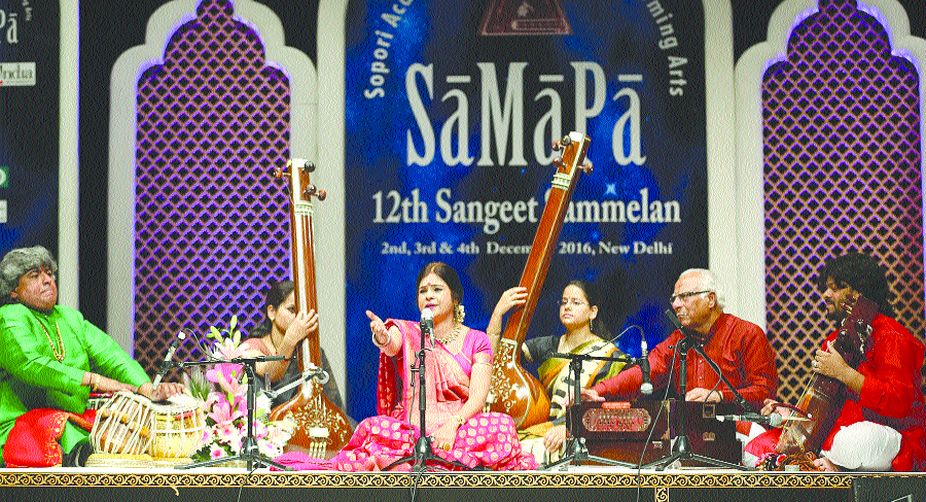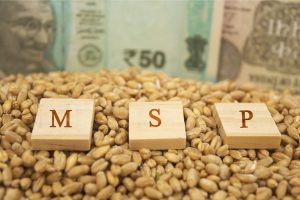The SaMaPa (Sopori Academy of Music And Performing Arts, New Delhi) is one of the premier organisations of India that is also recognised globally in the field of music and culture. SaMaPa, under the motivating guidance of its chairman Pandit Bhajan Sopori, is not just an academy but a cultural movement and it is acclaimed as the cultural bridge between the state of Jammu and Kashmir and rest of India. During its annual SaMaPa Sangeet Sammelan, acclaimed as the top most festival of Delhi and one of the most prestigious festivals of the country, the organisation ensures focus on the artistes hailing from Jammu and Kashmir.
This year the 12th SaMaPa Sangeet Sammelan was held at Kamani Hall in New Delhi. Though the motto of SaMaPa is Jan-jan tak sangeet (music to the masses), this national level platform for presentation, propagation, and teaching of traditional music and performing arts, apparently, also treads in the arena of fine arts. The flower-bedecked foyer of the prestigious venue wore the look of an art exhibition with vibrantly colourful paintings by artists from Kashmir.
Opening with a beautifully composed invocation song based on S-M-P — the
three most important notes that occupy 12 shrutis out of the 22 microtones of the saptak of Indian classical music — the soiree commenced with the recital of young talents Mehtab Ali Niazi (sitar) and Romaan Khan (tabla). After the vocal recital of Bholanath Mishra, Durjay Bhaumik (tabla) and Zakir Dhaulpuri (harmonium)), sitar exponent Gaurav Mazumdar, ably supported by Akram Khan (tabla), played raga puria.
The most creditable part of this soiree was its attention to dhrupad. As the final artiste of the first evening, Ustad Faiyaz Wasifuddin Dagar’s elaborate alap in raga jaijaiwanti was soothingly melodious. Unlike other members of the Dagar gharana who replicate the veena, his interpretation of the jod emulated the aural effects of the pakhawaj that incorporated some rare vowels. It was interesting; but soon after he lost the accuracy of sur in the upper octave. However, with motivating support of pakhawaj maestro Mohan Shyam Sharma, delighting bol baant (rhythmic divisions of lyrics) in chautal (Muraliya kaise baaji) compensated this flaw to a great extent. His next choice was raga malkauns.
To commence the melodic part of the evening, young sarangi maestro Kamal Sabri with his talented disciple as an accompanist and Rafiuddin Sabri on the tabla played saugandh, a treasured raga of his family handed down to him by his legendary father. Pandit Venkatesh Kumar adorned the stage next. Once again it was proved what an “oft-heard” evening raga like yaman (slow ektal and fast teental khayals) can do when reverentially treated by a maestro! The innovative phrases and powerful taans, highlighted by his full throated, rich voice and immaculate sense of balancing pathos with skilful playing made the recital extremely captivating. Sensitively supported by Keshav Joshi (tabla) and Vinay Mishra, he also sang two compositions in raga jaijaiwanti. Kolkata audiences are very familiar with these traditional Gwalior gharana bandishes (Tu hai malarani, medium-paced jhaptal and Bansari bajaye, fast teental).
As the final artiste of the second evening, Pandit Bhajan Sopori and his modified santoor showcased superb vocalism through meend, gamak and delicate kirtan-like phrases while playing raga kausi kanada (slow ektal and fast teental). His masterly crafted rhythmic variants received brilliant answers in the same mode on the tabla of Rashid Mustafa Thirakwa. Even at a break-neck speed, both displayed superb example of anticipation and suitable replies. A lot of gitkiri-like loops were created by the maestro with telling effect in the concluding kafi-tappa which turned out to be a unique item.
SaMaPa’s sincere effort to promote dhrupad was evident once more during
the three-day fest when young dhrupad-duo Milan (vocal) and Mahima (pakhawaj), worthy daughters-disciples of Pandit Ravishankar Upadhyay, regaled listeners with their stimulated but brief bageshri chautal and adana shooltal as the opening recital of the third evening. Mahima has already carved a niche for herself as a pakhawaj virtuoso. One was happy to note the progress of Milan as a rising dhrupadiya, a rare feat for a young girl of her age.
In a sheer contrast to dhrupad’s power-packed meend-gamak the delicate fine embellishments, accompanied by purab anga gayaki’s nuances were showcased by thumri exponent Malini Awasthi. Her Najuk baiyan kyun marori (Khamaj thumri, jat) came with beautiful bol-banav. The laggi, ably supported by Dharmanath Mishra (harmonium), Ramkumar Mishra (tabla) and Murad Ali’s emotive sarangi, had too many words for comfort and as such could not produce a crispy effect. Her kafi-pilu set to addha arrived with superbly emoted lyrics. She paid tributes to Ustad Rahat Ali, one of her learned gurus, through a Pahadi dadra with an unmistakable Punjabi (Patiala) flavour. Jadua daar gayi, a lively Tona-dadra (Kirwani) was the penultimate item of her enthralling recital and she concluded with Deewana kiye Shyam. This is her Guru Girija Devi’s oft-sung number but Awasthi interpreted it in her own way, and that was her success.
Young santoor maestro Abhay Rustam Sopori, supported by Mithilesh Jha (tabla) and Rishi Upadhyay (pakhawaj), chose to delineate a self-realised nirmalkauns. Despite being close to madhukauns and harikauns, the raga stood apart with its unique combination of gandhar and nishad. The beautiful gat-bandish (Jai-jai Nirmal Janani), composed by Abhay’s erudite father-guru, was set to ten and a half beats. Later at faster pace it switched on to ektal. As is his style, the young torchbearer of the Sopori Baaj, sang and played with élan and brought out the intrinsic devotional flavour of the raga while an emphasis on the skill-play gave it a thrilling character.
A bulls-eye aim was the most thrilling charm of kathak maestro Rajendra Gangani’s recital as the grand finale of the three-day extravaganza. It was amazing to note how he used each part of his sole for different effects with equal dynamism and how accurately he hit each of the sam (first beat of the rhythmic cycle) after a complex piece! His forceful, masculine movements were supported by equally inspired tabla of Fateh Singh Gangani and pakhawaj of young Rishi Upadhyay. Gangani’s presentation was essentially based on pure dance in teental; and, for a brief abhinaya, he chose a beautiful bhajan, Pawan mand sugandh. Composed by Pandit Madhup Mudgal, this was set to rupak.
SaMaPa has succeeded in creating a new generation of connoisseurs that recognise the contribution of individuals for their tireless efforts in propagating and keeping the traditional folk and classical culture alive.The award ceremony preceding the musicals on the second evening proved this point when Baba Yogendra and Shobha Kosar (heads of cultural institutions dedicated to promotion and propagation of Indian art and culture), Venkatesh Kumar (vocal), Kamal Sabri (sarangi), and this reporter (music appreciation and musicology) were warmly felicitated. The third evening commenced with the warm felicitation of Abdul Rashid Hafiz and Gulzar Ahmad Ganaie who have contributed a lot as Kashmir’s folk singers.
For a Cause
Rotary International district 3291 and district Governor Shyamashree Sen rganised a programme called Sangbardhan to commemorate Unesco’s World Heritage Day celebrations recently at the heritage site of Marble Palace in Kolkata in the presence of rotarians, consular representatives, members of Intach and other NGOs. A few of Bengal’s oldest families (the 800-year-old Mitra family, Cossimbazar Maharaja family, Mahishadal rajbari members, Dugar family of Murshidabad) were honoured on this occasion.
Its grand finale was a musical presentation on santoor by Pandit Tarun Bhattacharya. To suit the occasion his choice was a medley of three Tagorean songs (Boro Asha kore Esechi, Pran Chaye Chokkhu Na Chaye and Bhenge Mor Ghorer Chabi) to begin his concert as a tribute to the heritage buildings of Kolkata. From the medley he went straight to jhala in the seasonal raga hemant. At high speed the saath sangaat and saawal jawaab with Prosenjit Poddar on the tabla was thrilling and ended with a chakradhar tehai.
Advertisement
Advertisement
Advertisement
















